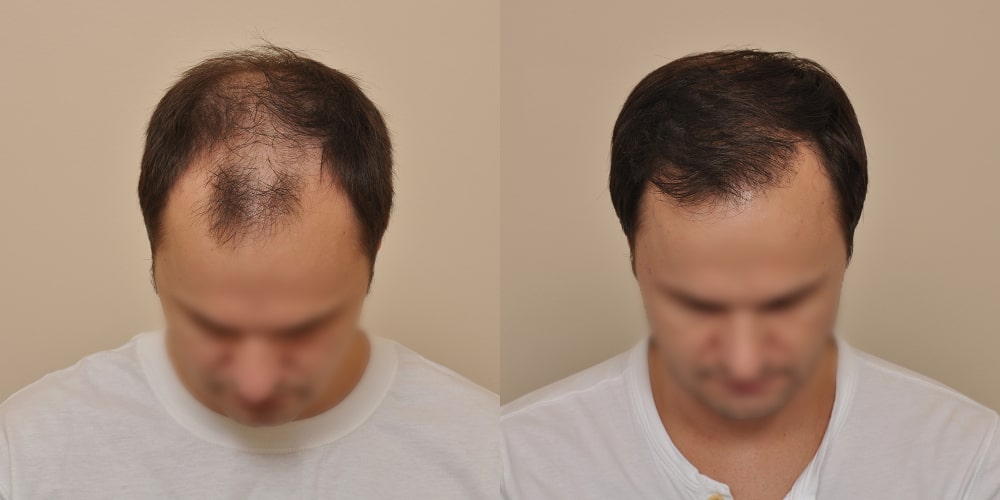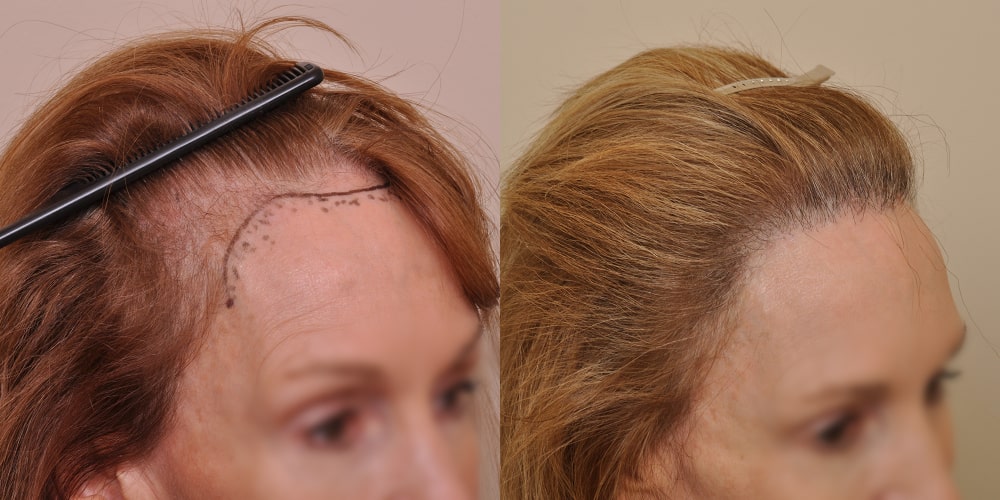HAIR RESTORATION BASICS
Is hair restoration surgery new to you? Start here.
Hair restoration surgery, also known as hair transplantation, is a specialized procedure designed to address the visible scalp, aka baldness, that hair loss leaves behind. In the hands of a skilled surgeon and technician team it’s a minimally invasive surgical technique that involves relocating hair follicles from the donor area (usually the back and sides of the scalp) to the recipient area (areas where hair is thinning or absent). The outcome, in properly selected candidates, is permanent, natural, growing hair growth.
BESTSELF “BEST IN ATLANTA” AND ATLANTA MAGAZINE “TOP DOCTOR” EVERY YEAR SINCE 2014.
EVERYTHING YOU NEED TO KNOW ABOUT HAIR RESTORATION
Why does hair restoration surgery work?
Hair restoration surgery works thanks to the concept of donor dominance – the ability of hair follicles from the “permanent zone” to maintain their genetic traits even when they are transplanted to a different area of your scalp. This means that when hair follicles are taken from the donor area on the back or sides of your scalp, they keep their original genetic code and continue to grow just as they would in their original location.
During your hair restoration surgery, your surgeon will carefully select and extract healthy hair follicles from the donor area. These follicles will then be transplanted into the recipient area where hair loss has occurred. Thanks to the concept of donor dominance, these transplanted follicles will continue to grow and flourish in their new location, behaving just as they did in the donor area. They will be resistant to the effects of DHT and maintain their natural growth pattern, texture, and color.
How is candidacy determined?
To determine if you qualify for hair restoration surgery, the most efficient approach is to schedule an in-person consultation with our team at the Anderson Center for Hair. During this one-hour consultation, we will thoroughly assess your hair loss history and examine your scalp at a microscopic level. We will also take 360-degree baseline photographs and engage in a comprehensive discussion about potential treatment options, including surgical choices and associated costs.
During your consultation, your doctor will evaluate whether there are any contraindications that would prevent you from undergoing hair restoration surgery. Here are some of the reasons, known as contraindications, which might exclude you from being a suitable candidate:
- Diffuse Unpatterned Alopecia (DUPA): If you have been diagnosed with DUPA, unfortunately, hair restoration surgery is not a viable option. DUPA causes hair loss across the entire scalp, including the sides and back, which are typically considered the “permanent zone.” Without a source of terminal hairs (hair that is not susceptible to miniaturization over time) to harvest, transplantation is not possible.
- Scarring Alopecia: Also known as cicatricial alopecia, this specific form of hair loss is characterized by an autoimmune response where the immune system mistakenly attacks the hair follicles. This leads to the formation of scar tissue, which replaces the hair follicles. As scarring alopecia causes irreversible damage to the follicles, transplanted healthy hair follicles would also be subjected to the same autoimmune attack and unable to produce hair. Therefore, individuals diagnosed with scarring alopecia are not suitable candidates for hair restoration surgery.
- High Blood Pressure: If you have high blood pressure that is not well-managed with medication, it can increase the risk of bleeding and other complications during and after surgery. Prior to considering hair restoration surgery, it is important to work with your primary care doctor or cardiologist to control your blood pressure. On the day of surgery, your vitals will be checked, and if your blood pressure is too high, your surgeon may have to cancel the procedure.
- Clotting Disorders: Individuals with clotting disorders have a higher risk of excessive bleeding during surgery, including hair restoration. If you have a clotting disorder, it is crucial to discuss this with your surgeon to understand the associated risks and determine if hair restoration surgery is suitable for you.
- Uncontrolled Diabetes: Diabetes, particularly when it is not well-controlled, can impede the healing process after surgery and increase the risk of infection. It is advisable to strive for good control of your blood glucose levels before undergoing any surgical procedure.
In addition to medical contraindications, there are other factors that serve as safety guardrails for our patients and surgeons at the Anderson Center:
- Age: For frontal hairline restorations, patients must be at least 25 years old, and for surgery on the top and back of the head (crown or vertex), patients must be at least 30 years old. Limitations exist on the amount of hair that can be transplanted over a lifetime. If you anticipate needing multiple procedures over time, it’s important to allocate resources strategically to ensure our surgeons can create a natural-looking and long-lasting result. While performing hair restoration on younger patients is legally permissible, starting the procedure too early may compromise long-term well-being.
- Insufficient Donor Hair: Hair restoration surgery relies on transplanting healthy hair follicles from the donor area to the thinning areas. However, there are cases where there might not be enough donor hair to achieve aesthetically pleasing results that align with your expectations. Our surgeons will provide thoughtful guidance during your consultation, considering both technical possibilities and aesthetic outcomes.
- Expectations: It is important to have realistic expectations when considering any cosmetic procedure, including hair restoration surgery. While hair restoration can significantly improve your appearance and self-confidence, it’s essential to understand that it may not fully restore the exact hair density or hairline you had during your teenage years. During your consultation, our surgeons will be more than happy to address any questions or concerns you have, ensuring that you have a clear understanding of the achievable outcomes.
Should I have an FUE or FUT procedure?
When considering hair restoration surgery, it’s important to understand the two primary harvesting methods: FUE and FUT. The decision between FUE and FUT harvesting depends on various factors, such as the pattern and extent of your hair loss, quantity and quality of your donor hair, and personal preferences. You can schedule an appointment with your doctor to discuss your options or take a deeper look at each option below.
In follicular-unit transplantation (also known as the “strip method”), a long, thin piece of tissue is removed from the back of the scalp. Individual follicular units are then removed from the strip using stereo-microscopic dissection.
FUE involves extracting individual hair follicles from the donor area using a micro-punch tool, leaving tiny scars that are easily concealed, even with very short haircuts.
What should I expect during my hair restoration procedure?
- Consultation: Your journey begins with a consultation, either in-person or virtual, with one of our patient coordinators and surgeons. This is an important step that gives you and your surgeon the opportunity to discuss your hair loss and the possible causes, determine if you’re a good candidate, choose the best harvesting method, and set reasonable expectations for the outcome of your surgery.
- Consent Forms: To start your surgical procedure, you’ll be given paperwork to fill out, which will include your medical history and any allergies or medical conditions that you may have. You’ll also be required to sign consent forms, which acknowledge that you understand the risks and potential complications of the surgery.
- Surgeon and patient discuss and design the recipient area: Your surgeon will examine your scalp and hair distribution, discuss your expectations, and design a recipient area that will provide the most natural-looking results. For hairline cases, your surgeon will draw your hairline in place to give you an idea of what to expect.
- Anesthesia: On the day of the procedure, local anesthesia is applied to the areas that will be involved in the surgery. This will ensure you don’t experience any pain. You will also be given antibiotics to prevent infection, steroids to minimize swelling, plus sedatives such as Valium and Versed, which are used to help you relax during the procedure. You will be awake during the harvesting phase of the procedure so you can communicate with the surgeon as needed. Most patients fall asleep during the implantation portion of the procedure.
- Harvesting the follicles: This step involves removing healthy hair follicles from the donor area on the back or sides of the scalp where hair is resistant to balding. This can be done through various techniques, such as FUT and FUE. Both techniques aim to harvest hair follicles with minimal damage so they can grow successfully in the recipient area.
- Technicians process the follicles: Once the hair follicles are harvested, they are then processed and prepared for transplantation by a team of experienced technicians. Depending on the method of extraction, this includes slivering, trimming, and sorting follicles under a microscope.
- Site creation in the recipient area: Your surgeon will create recipient sites in the areas of your scalp where you want hair to grow. These sites are tiny incisions made at the correct angle and depth to match your natural hair growth. This is a meticulous process that determines the final “look” of your result and requires exceptional skill and precision.
- Graft Placement: The prepared hair follicles, now known as grafts, are then placed into the previously created recipient sites. This step is time consuming as each and every individual follicle must be planted into it’s own tiny incision.
- Post-op instructions: After the surgery is complete, the team will provide you with post-operative instructions verbally and in writing. These will include guidance on how to care for your scalp, medication to take, and a schedule for returning to your usual activities.
What is the recovery process like?
Immediately after the procedure, your head will be wrapped and covered with a surgical cap. You may experience tenderness, swelling, and minor bleeding in the transplant areas.
On the day after the procedure, you will remove the bandages and start using the “cup method” to wash your hair as instructed in your post-op paperwork. You’ll also spray a provided solution on your newly-implanted grafts every few hours. Swelling may continue, moving from the scalp down to the forehead and around the eyes during the first week, peaking around days three to five. Small scabs will also form around each graft. Around day 10, the scabs will begin to fall off naturally, and you should avoid picking them. Some hair might be shed along with the scabs, but this is normal, and new hair will start to regrow in a few months.
If you had an FUT (linear) surgery, the sutures in the donor area will be removed on day 14.
By the end of the first month, the transplanted hairs will start to shed, which is a normal part of the process. The redness and scabs should have largely disappeared, and your scalp may look more normal. In the following months, you may see some new growth from the transplanted hair follicles, but it may be less than before the procedure as the follicles enter a resting or dormant phase. Do not worry, as this is expected, and your new hair is preparing to grow.
Around months four to six you will notice more noticeable hair growth, with the transplanted hairs thickening and filling in the treated areas. From six months to a year, the transplanted hair will continue to thicken and grow, and by the end of the first year, you should see the final results of the transplant, with a fuller and more natural-looking head of hair.
Check out our patient photo journal to see photos throughout the process and get an idea of how your hair may look as you recover.








































